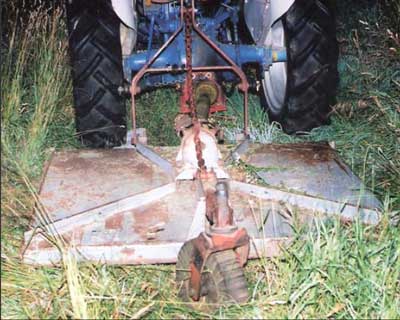Farmer Run Over by Tractor and Rotary Cutter
Iowa Case Report: 04IA021
Report Date: June 22 2007
Summary
A 53-year-old man died in southwestern Iowa early in the summer of 2004 when he fell from his tractor under its rear wheel and the trailing rotary cutter. The incident happened in the late evening darkness. He was operating an old, small tractor with a rotary cutter mounted on its rear three-point hitch. The tractor had a wide front axle but was not equipped with a cab, roll-over protective structure (ROPS) or the seatbelt which is an integral component of standard ROPS installations. The farmer was mowing weeds when the wheels on the right side of the tractor ran over a tree stump. The farmer was pitched from his operating position on the tractor to the ground ahead of the tractor’s left rear wheel. The tractor and rotary cutter combination stalled with the farmer under the rotary cutter. Discovered by a neighbor, who immediately summoned emergency assistance, the farmer died from an open laceration to his chest before emergency personnel arrived.
RECOMMENDATIONS:
- Operators should follow tractor and rotary cutter operator’s manual instructions, safety messages and safety signs, and all applicable safe operating practices when using rotary cutters.
- Rotary cutters, especially when operated on adverse terrain, should be used with tractors that have ROPS and seatbelt.
- The area to be mowed should be scouted, and cleared of debris, with all obstacles effectively marked if they cannot be removed.
- Rotary cutters should be operated when lighting is sufficient to expose marked and unmarked obstacles, debris, uneven terrain, and other hazards.
Introduction
Neighbors observed the 53-year-old farmer mowing weeds around dusk. He was discovered several hours later underneath the rotary cutter at the rear of his stalled tractor. The incident was not witnessed. Iowa FACE investigators became aware of it through a newspaper article two days after the incident. Information for this report was drawn from accounts and photographs by County Sheriff’s personnel and the Medical Examiner’s office. The cause of death was determined to be an open chest wound.
Investigation
The victim was last seen alive by a neighbor around 7 PM the evening of the incident. He was mowing brush and grass with a tractor and the attached rotary cutter. The grass was 3 ft (1 m) tall. He was using a 5-ft (1.5 m) wide, power takeoff (PTO) powered rotary cutter mounted on the rear three-point hitch of a 27 PTO Hp (20 kW) tractor that was over 50 years old. The tractor had a wide front axle configuration. Its rear wheel track width fit the width of the rotary cutter’s swath. The tractor did not have a cab, ROPS or seatbelt.
Officials estimated the farmer was still “brush hogging” with his tractor and rotary cutter combination about 10 PM when the wheels on the right side of the tractor drove up on a tree stump that was hidden in the tall grass. The farmer was pitched from his position on the tractor to the front left, ahead of the tractor’s left rear drive wheel. The tractor continued forward. Its left rear wheel ran over the farmer’s neck and chest and the PTO powered rotary cutter followed as the farmer went under its deck (Photo 1). The tractor engine stalled and power to the rotary cutter stopped with the victim pinned between the left front quarter of rotary cutter and the ground.
 |
|
Photo 1 – PTO-powered rotary cutter attached to the tractor’s three-point hitch.
|
The victim was found about an hour before midnight by a neighbor, who called for emergency assistance. It was apparent to the neighbor and to arriving law enforcement and emergency personnel that the victim was deceased.
Cause of Death
The cause of death was multiple traumatic injuries. Prominent among them were an open laceration to the chest and near amputation of the right arm.
Recommendations/Discussion
Recommendation #1 Operators should follow tractor and rotary cutter operator’s manual instructions, safety messages and safety signs, and all applicable safe operating practices when using rotary cutters.
Discussion: The four year period in which this retiree-turned-farmer acquired parcels of farm land, including one with a dwelling on it, suggests he may not have had many years of experience operating tractors and rotary cutters. Small and family farms most often do not have formal safety training programs and rely on safety information and resources from many sources. Of foremost importance among these resources is the operator’s manual for each piece of equipment. Operator’s manuals contain information on recommended safety equipment and the safety features of each machine. Operator manuals also contain general safety information and precautions. They describe the basic safety-related situations that may be encountered and suggest how to manage such situations. Among the safety equipment recommended when using rotary cutters is ROPS on the tractor, along with the safety practice of using the seatbelt that comes with ROPS. This enables the operator to avoid accidentally falling off the tractor when going over rough terrain or in sharp turns, and possible injury or death from tractor or equipment runover, by using the seat belt which is an integral part of ROPS-equipped tractors. In this case both the tractor and rotary cutter were old. Original operator’s manuals may not have been readily available. The original equipment dealer, a dealer providing similar products, the cooperative extension service, and resources on the internet and elsewhere can contribute to an operator’s understanding of the currently recommended safety equipment and safe operating practices to follow.
Recommendation #2 Rotary cutters, especially when operated on adverse terrain, should be used with tractors that have ROPS and seatbelt.
Discussion: The tractor in this incident had no ROPS or seatbelt available for it when it was manufactured in the early 1950’s or before. While the primary purpose of ROPS and seatbelt is to protect the operator in the event of an overturn, the ROPS structure and seatbelt can also be important in preventing an operator from being thrown from the tractor. ROPS are commercially available, from either the original tractor manufacturer or from aftermarket sources, for tractors built since 1970 and for many makes and models built prior to that time. Rollover protection includes a seatbelt to keep the operator in a protected zone and restrains them from being thrown from the tractor. A seatbelt should not be installed or used on a tractor that does not have rollover protection. A ROPS with seatbelt installed on the tractor in this incident of sudden, rough, and unexpected movement without the tractor actually overturning could have prevented the operator from being pitched off and subsequently runover. Equipment dealers, Cooperative Extension, and the internet can provide information on sources of ROPS.
Recommendation #3 The area to be mowed should be scouted, and cleared of debris, with all obstacles effectively marked if they cannot be removed.
Discussion: Rotary cutters are designed and intended for many uses, including use in clearing areas overgrown with grass, weeds, and brush. This growth can easily obscure rough terrain, steep or changing slopes, holes, bumps, washouts, ruts, rocks, stumps and other obstructions that could cause at tractor to overturn, the operator to lose control, or pitch the operator off the tractor. The area should be scouted before it is cut. Any debris, obstacles, and adverse terrain conditions should be eliminated or, if they cannot be eliminated, be clearly marked to avoid tractor upsets and dangerous driving conditions.
Recommendation #4 Rotary cutters should be operated when lighting is sufficient to expose marked and unmarked obstacles, debris, uneven terrain, and other hazards.
Discussion: Darkness, low light, and shadows make it more difficult to recognize hazards that were marked because they could not be removed as well as those hazardous conditions that were not discovered in advance. Performing rotary cutter operations when there is adequate light can help prevent safety as well as maintenance and repair problems.
References
- AEM. 1990. Agricultural Tractor – Safety manual for operating and maintenance personnel. Milwaukee, WI: Association of Equipment Manufacturers. Available at https://www.aem.org.
- AEM. 2000. Industrial / Agricultural Mower – Safety manual for operating and maintenance personnel. Milwaukee: Assn of Equipment Manufacturers. Available at https://www.aem.org.
- ASABE Standards. 2006. S318.16: Safety for agricultural field equipment (Section 11). St. Joseph, MI: American Society of Agricultural and Biological Engineers.
- ASABE Standards. 2006. S474.1: Agricultural rotary mower safety (Annex A). St. Joseph, MI: American Society of Agricultural and Biological Engineers.
- Deere & Co. 1994. Chapter 13: Farm maintenance equipment. In Farm and Ranch Safety Management, 4th ed., 303-6. Moline, IL.
- FEMA. Important safety message for owners / operators of rotary cutters. St. Louis, MO: Farm Equipment Manufacturers Association. Available at http://www.farmequip.org/safety/rotary_cutter_safety. Accessed 31 August 2006. (Link updated 3/20/2013)
- NASD. 2002. Agricultural mower safety. Canadian Farm Safety Association, Inc. Guelph, ON CAN. Available at http://www.nasdonline.org/index.html. Accessed 19 July 2007. (Link updated 8/5/2009)
- NFMC. 1997. A guide to agricultural tractor rollover protective structures. Marshfield, WI: National Farm Medicine Center. Available at http://www3.marshfieldclinic.org/NFMC//?page=nfmc_rops_guide. Accessed 18 August 2006. (link updated 4/4/2013)
Iowa FACE Program
Fatality Assessment and Control Evaluation, FACE, is a program of the National Institute for Occupational Safety and Health (NIOSH), which is part of the Centers for Disease Control and Prevention of the U.S. Department of Health and Human Services. Nationally, the FACE program identifies traumatic deaths at work, conducts in-depth studies of select work deaths, makes recommendations for prevention, and publishes reports and alerts. The goal is to prevent occupational fatalities across the nation.
The NIOSH head office in Morgantown, West Virginia, carries out an intramural FACE case surveillance and evaluation program and also funds state-based programs in several cooperating states. In Iowa, The University of Iowa through its Injury Prevention Research Center works in conjunction with the Iowa Department of Public Health and its Office of the State Medical Examiner to conduct the Iowa FACE program.
Nationally, NIOSH combines its internal information with that from cooperating states to provide information in a variety of forms which is disseminated widely among the industries involved. NIOSH publications are available on the web at https://www.cdc.gov/NIOSH/FACE/.
Iowa FACE also publishes its case studies, issues precautionary messages, and prepares articles for trade and professional publication. In addition to postings on the national NIOSH website, this information is posted on the Iowa FACE site, http://www.public-health.uiowa.edu/FACE/. Copies of FACE case studies and other publications are available by contacting Iowa FACE, too.
The Iowa FACE team consists of the following specialists from the University of Iowa: Craig Zwerling, MD, PhD, MPH, Principal Investigator; John Lundell, MA, Co-Investigator; Murray Madsen, MBA, Chief Trauma Investigator; and Co-Investigator/specialists Risto Rautiainen, PhD, and Wayne Sanderson, PhD, CIH. Additional expertise from the Iowa Department of Public Health includes Rita Gergely, Principal Investigator, and John Kraemer, PA, from the Office of the State Medical Examiner.
To contact Iowa State FACE program personnel regarding State-based FACE reports, please use information listed on the Contact Sheet on the NIOSH FACE web site Please contact In-house FACE program personnel regarding In-house FACE reports and to gain assistance when State-FACE program personnel cannot be reached.

